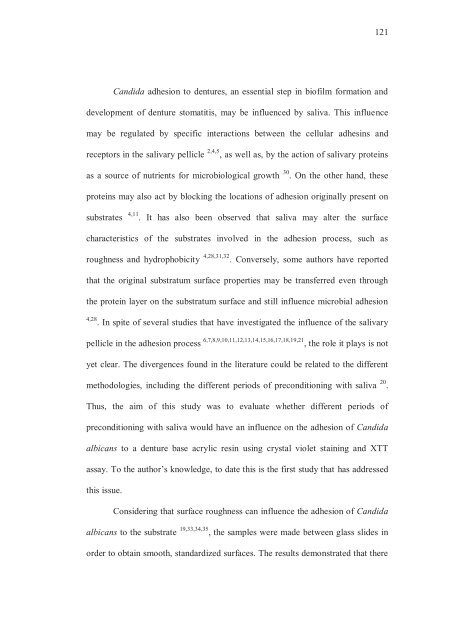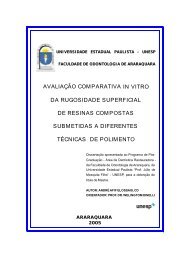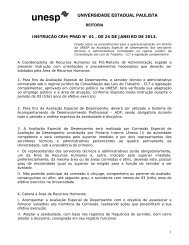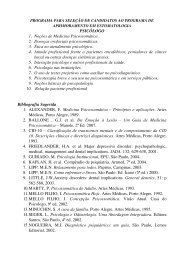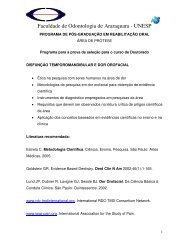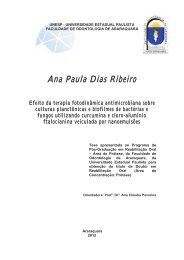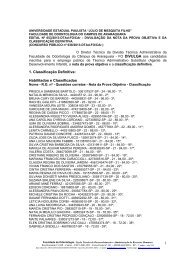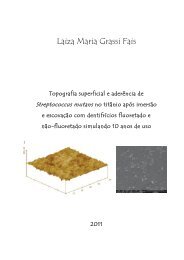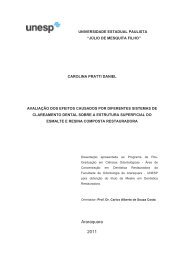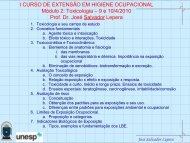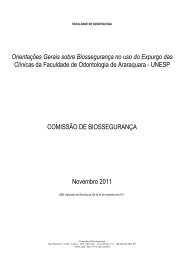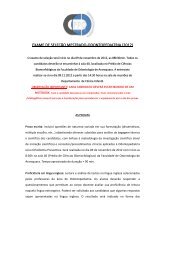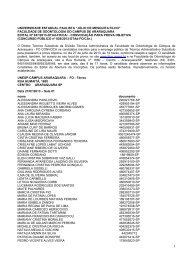universidade de são paulo - Faculdade de Odontologia - Unesp
universidade de são paulo - Faculdade de Odontologia - Unesp
universidade de são paulo - Faculdade de Odontologia - Unesp
Create successful ePaper yourself
Turn your PDF publications into a flip-book with our unique Google optimized e-Paper software.
121<br />
Candida adhesion to <strong>de</strong>ntures, an essential step in biofilm formation and<br />
<strong>de</strong>velopment of <strong>de</strong>nture stomatitis, may be influenced by saliva. This influence<br />
may be regulated by specific interactions between the cellular adhesins and<br />
receptors in the salivary pellicle 2,4,5 , as well as, by the action of salivary proteins<br />
as a source of nutrients for microbiological growth 30 . On the other hand, these<br />
proteins may also act by blocking the locations of adhesion originally present on<br />
substrates 4,11 . It has also been observed that saliva may alter the surface<br />
characteristics of the substrates involved in the adhesion process, such as<br />
roughness and hydrophobicity 4,28,31,32 . Conversely, some authors have reported<br />
that the original substratum surface properties may be transferred even through<br />
the protein layer on the substratum surface and still influence microbial adhesion<br />
4,28 . In spite of several studies that have investigated the influence of the salivary<br />
pellicle in the adhesion process 6,7,8,9,10,11,12,13,14,15,16,17,18,19,21 , the role it plays is not<br />
yet clear. The divergences found in the literature could be related to the different<br />
methodologies, including the different periods of preconditioning with saliva 20 .<br />
Thus, the aim of this study was to evaluate whether different periods of<br />
preconditioning with saliva would have an influence on the adhesion of Candida<br />
albicans to a <strong>de</strong>nture base acrylic resin using crystal violet staining and XTT<br />
assay. To the author’s knowledge, to date this is the first study that has addressed<br />
this issue.<br />
Consi<strong>de</strong>ring that surface roughness can influence the adhesion of Candida<br />
albicans to the substrate 19,33,34,35 , the samples were ma<strong>de</strong> between glass sli<strong>de</strong>s in<br />
or<strong>de</strong>r to obtain smooth, standardized surfaces. The results <strong>de</strong>monstrated that there


